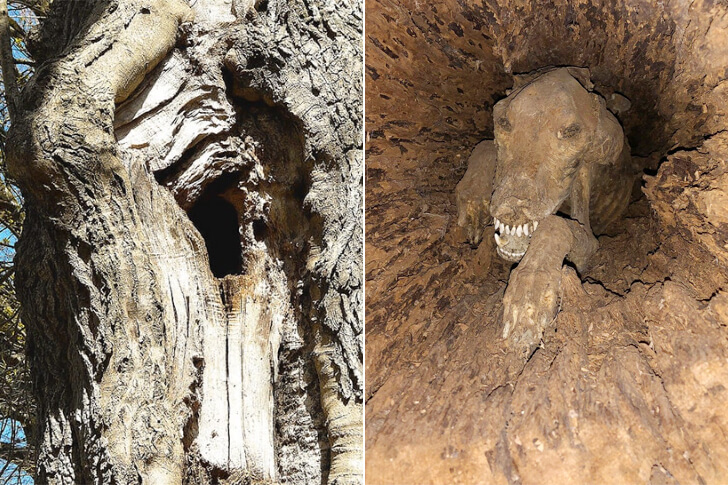
It was June 1980 when eight Georgia Kraft loggers bounced along a dirt road outside Jasper, Georgia, sipping coffee and swapping weekend stories. They were due to finish clearing a marked section of American chestnuts by late afternoon. A drizzle smeared the windshield, but nobody minded. These men had worked together for years and knew the rhythm.
After lunch, they turned to one final tree that had raised eyebrows earlier. Pete Alvarez had knocked on it that morning and said it sounded too hollow for its size. Tom Jenkins agreed, and the group gathered as Pete restarted his chainsaw. But this would be no ordinary cut.
Chainsaw Pause
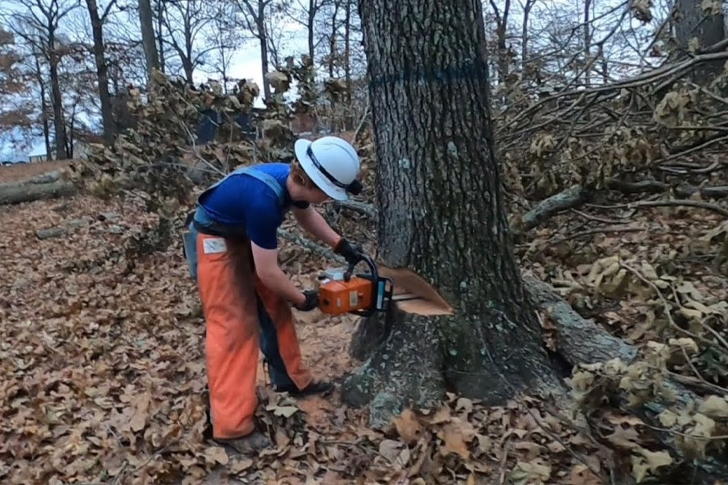
Pete’s chainsaw made contact with the bark and instantly jammed. Instead of splintering cleanly, the blade recoiled like it had struck bone. Dust sprayed oddly dark, the color of dried blood instead of raw wood. He backed up fast, cutting the engine, while Tom moved in to inspect the strange gash.
Inside the fresh groove, the exposed cavity didn’t follow a typical hollow pattern. It had a shape. Depth. Purpose. And that odd, musty scent didn’t match rot or mold. The entire crew paused. Some joked about hitting buried treasure, but their tone was off. Jokes like that usually came easy. This time, no one really laughed.
Gray Dawn
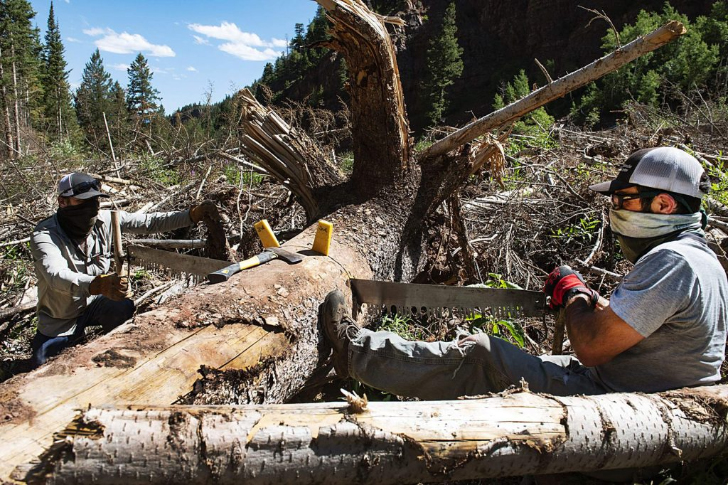
The weather hadn’t lifted since the morning drive. Clouds hung low, and the woods seemed unnaturally still. Even the birds had gone silent. The men gathered around the tree, unsure what to make of the shadow inside the exposed section. Pete reached for his flashlight and slowly angled it inside.
The light didn’t travel far. Something blocked it, but not in a way that made sense. It wasn't another tree limb or a bird nest. There was a shape in there, a form that gave everyone pause. One of the younger loggers, Vince, murmured, “That’s no hollow.” Tom didn’t respond. His instincts were already screaming.
Tree Town Ties
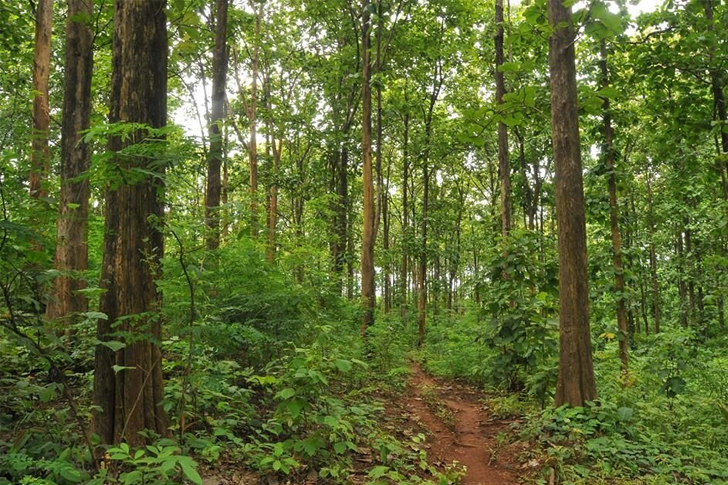
Jasper wasn’t just a timber town. It was the timber town. Nearly every household in the area traced its livelihood to the logging industry. Georgia Kraft paid the bills, funded the schools, and stocked the shelves at the general store. The work was hard, the pay steady, and the men proud.
Tom Jenkins, like most of the crew, had family in every branch of the business. But pride gave way to caution as they examined the tree again. Logging teaches respect for weight, pressure, and instinct. And right now, something about that chestnut was off. If the town’s heartbeat came from the forest, this tree had just skipped a beat.
Chestnut Secret
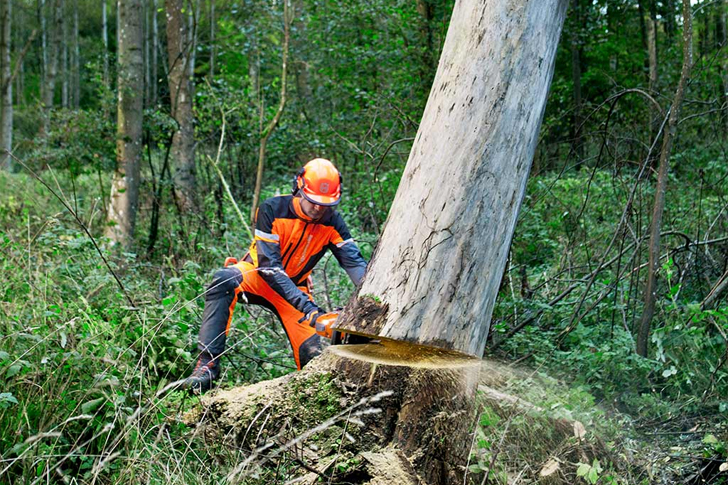
American chestnuts used to dominate the eastern forests before a blight nearly erased them in the early 1900s. This part of Georgia was one of the few places where they still grew in respectable numbers, making them valuable harvest targets. The chestnut in question, however, didn’t behave like the others.
Pete had remarked earlier that it felt too light when he marked it, which usually meant rot or insect damage. But there had been no outward signs of decay. Now, with that carved opening gaping back at them, it was clear the tree had a secret. And whatever that secret was, it wasn’t meant to be discovered.
The Tree's Odd Secret
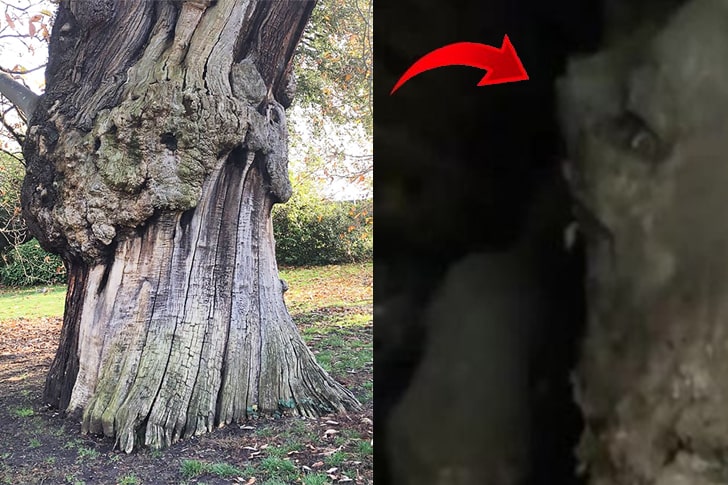
Pete made another careful cut along the trunk, hoping to create manageable pieces for transport. As he split away the bark, he paused. There was no hollow tunnel running through as expected. Instead, something dense filled the interior. It wasn’t solid wood, and it didn’t reflect light properly either.
Tom reached in with a gloved hand, feeling resistance. “Should be daylight coming through,” he said, peering into the murk. But the light from Vince’s flashlight hit a surface that absorbed it like cloth. Not bark. Not sap. Something else entirely. A shape blocked the path. A presence. That’s when the real tension started to build.
Shadow in the Trunk
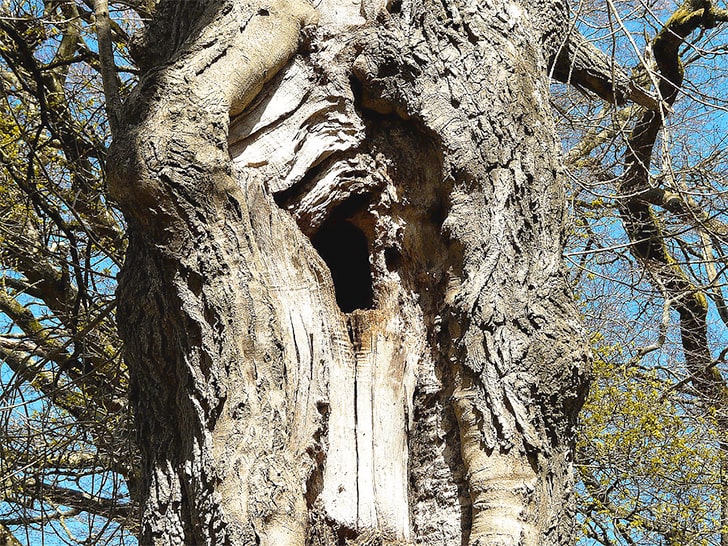
From a distance, it looked like the tree had a black hole in its center. The men began calling it “the void,” trying to joke away the unease. Pete angled his flashlight in again, and the beam simply disappeared. There were no curves of bark, no hollow echo, no movement. Just darkness.
Speculation ran wild. Maybe it was an animal burrow, or some forgotten moonshiner's stash. But none of those guesses explained the size or the smell—a dry, earthy odor that wasn’t rot, but still unnatural. Curiosity turned to apprehension. Whatever was inside, it hadn’t been meant to be disturbed. And now it definitely had been.
Who Goes First?
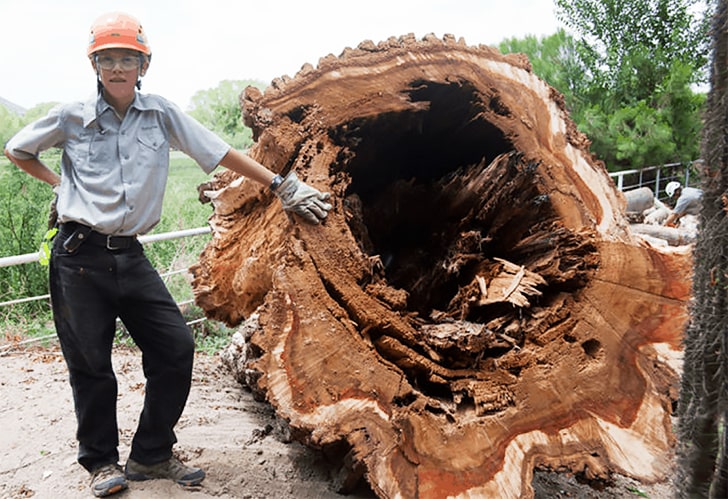
Nobody was eager to stick their head into a blackened hole in the middle of a tree. The crew cracked nervous jokes, but none stepped forward. Tom looked at each man’s face and saw the same answer. Curiosity, sure, but caution always won among loggers. That instinct had kept them alive.
Pete finally shrugged. “Fine, I’ll do it.” He tied a bandana over his nose, flicked on a flashlight, and knelt to peer deeper into the shadow. His knees hit damp mulch as he leaned inside the cut. The others held their breath. Seconds passed. Then a noise, sharp and startled, came tearing out of the hollow.
Man vs. Unknown
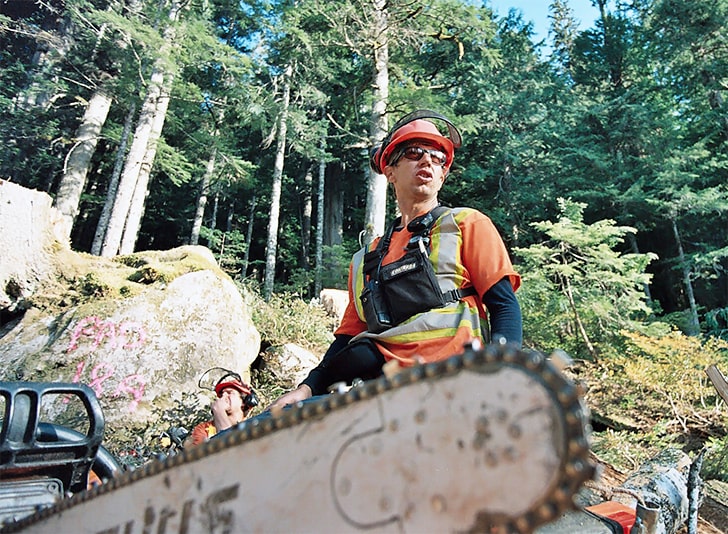
Pete yanked himself backward so violently that he fell onto the forest floor. His hard hat clattered behind him as he scrambled to his feet, pale and speechless. The others swarmed, asking what happened. He couldn’t speak right away. It took a full minute for him to find words again.
“Something’s in there,” he finally whispered. “Something dead. Or alive. I don’t know.” No one laughed. His eyes were wide and glassy, not the look of someone pulling a prank. For a man who once fell into a creek wrestling a gator, this was different. Pete shook his head slowly. “It’s not hollow. It’s… watching.”
The Beast Inside
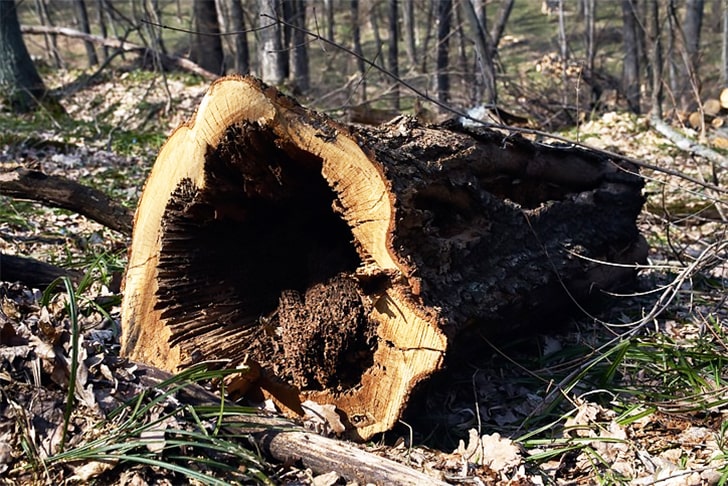
Tom helped Pete to a log and pressed a water bottle into his hand. Vince and another logger, Darren, circled the tree, trying to spot anything from other angles. One of them chuckled nervously. “What’d you see, Sasquatch?” But even the joke felt flat. The mood had shifted completely.
Pete steadied his breath and muttered, “It had teeth. Big ones. I swear to God, I saw a face.” Nobody spoke for a moment. A face? Inside a tree? It sounded like nonsense, but Pete wasn’t the type to exaggerate. Darren pulled out his knife and stepped closer. “Well, let’s find out what kind of beast lives in trees.”
Shock and Skepticism
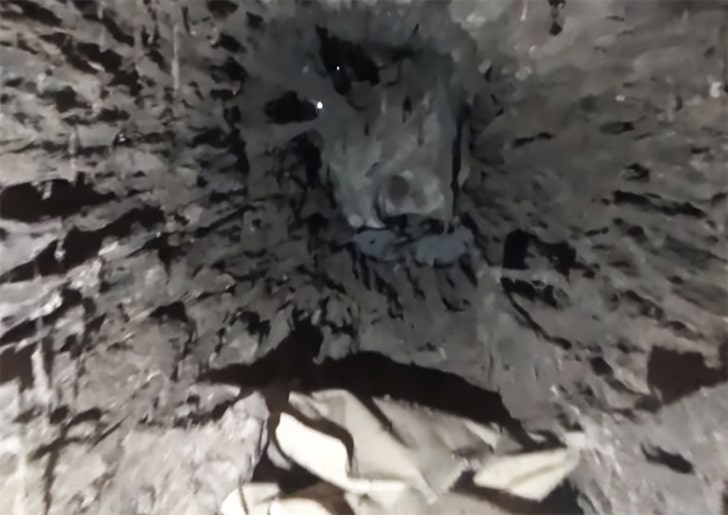
Pete’s reaction alone should’ve convinced them, but in a work crew full of pranksters, disbelief came first. Darren muttered, “Probably planted a squirrel skull in there,” and crawled in to see for himself. But when he backed out a minute later, his face was pinched and pale. “It’s... not a joke,” he said quietly.
One by one, the others took turns looking into the hollow. No one spoke much afterward. Something wasn’t right. It wasn’t just a dead animal. It looked trapped. The tree wasn’t hollow all the way through, and the creature inside, whatever it was, had no business being there. The tree was now completely unusable.
Get the Boss
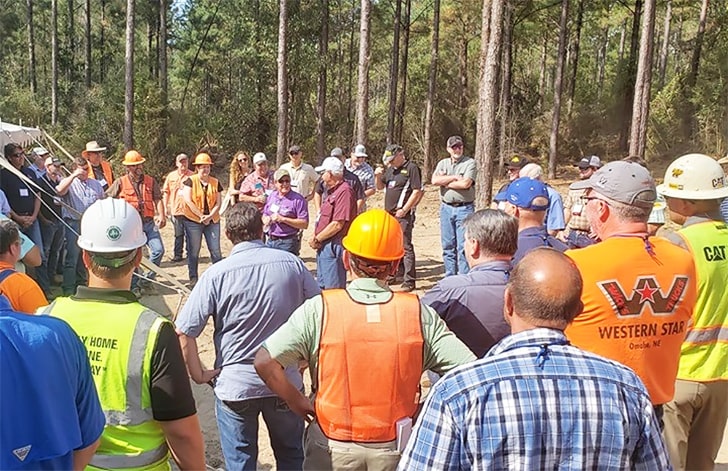
Tom pulled out the radio again, finally reaching the site supervisor. He described what they’d found, careful not to sound crazy. “It might be an animal. But it looks... preserved. Intact. Like it’s been in there for decades.” The supervisor sighed, then told them to log the rest of the marked trees and not to waste more time on it.
But Tom wasn’t so sure they should keep cutting. If what they found was valuable or maybe even historical, destroying it could mean trouble. Pete agreed. “This isn’t normal deadfall,” he said. The others stood around the chestnut silently, already sensing that today’s job had become something else entirely.
Disobeying Orders
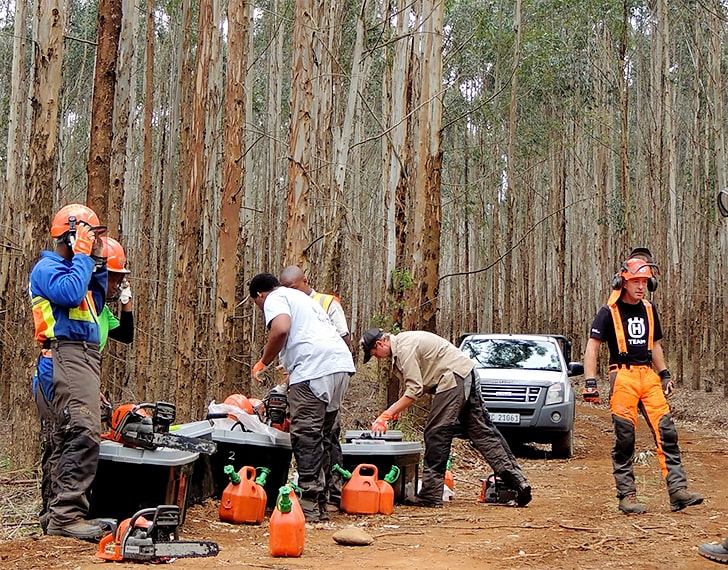
After another radio call, the instructions didn’t change. “Get back to work,” the manager said flatly. “If it’s not marked for recovery, we don’t want delays.” But by now, the crew had stopped pretending this was just another tree. They’d seen something unusual. And if they ruined it, that might cost more than the lost timber.
Pete folded his arms and said, “Forget the quota. If this is important, we’re not slicing it up.” Tom agreed. “Let’s set it aside, finish the rest, and figure out what we’re dealing with.” They took a vote, unofficial but unanimous. No more chainsaws near that chestnut. Something in there deserved better.
Frozen in Time

By now, everyone had seen it—legs, a jawline, the curve of a snout. Someone even thought they saw fur clinging to the bone. “It looks like it was trying to climb back out,” Vince said, voice low. “Like it got stuck and just... froze.” That possibility sent a chill through all of them.
It didn’t look ancient, but it definitely wasn’t fresh. The position was unnatural, rigid. The creature had been mid-movement when it died. And something about its shape made even the boldest men pause. A beast, yes, but not some unknown monster. Something familiar. Something domestic. They needed answers.
Finally, a Real Guess
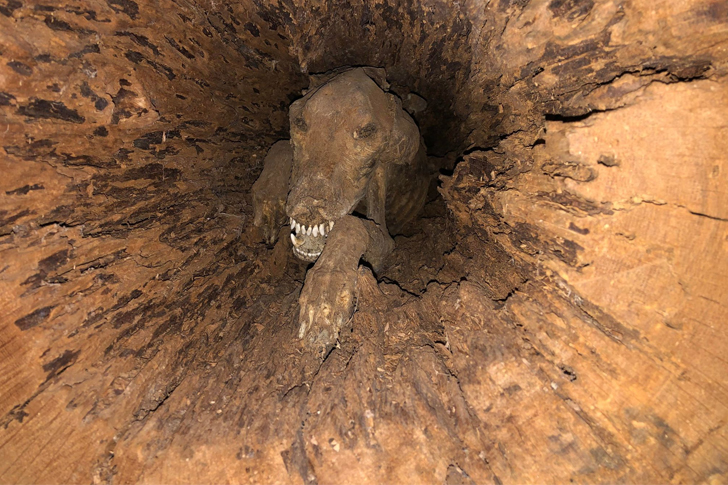
Tom leaned in with a better flashlight and got the clearest view yet. “Look at the teeth,” he said. “That’s not a wildcat or a possum. That’s a dog.” Pete knelt beside him, nodding slowly. “Long nose, paws, curled spine. He must’ve gone in chasing something—and never came back out.”
Realization spread like a wave. They hadn’t found a beast. They’d found someone’s pet. Maybe even a working dog, like the ones hunters used in these woods decades ago. The mood shifted again, from fear to sadness. “He got stuck in there,” Vince said softly. “That poor thing tried to survive and never made it.”
Echoes of Egypt
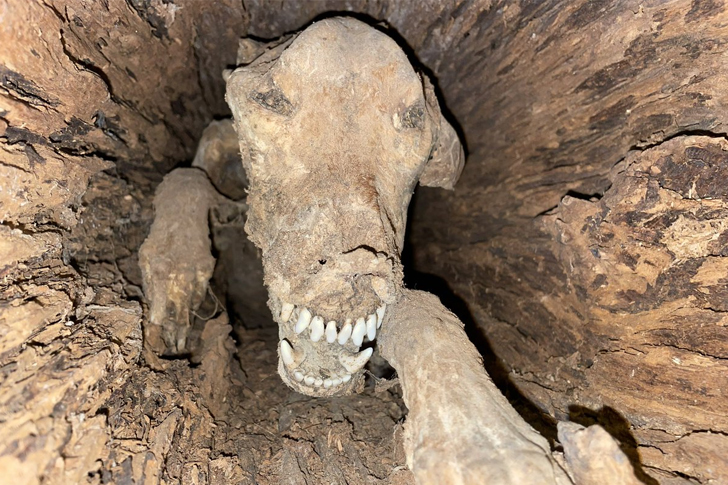
Someone at the site called it a “forest sarcophagus,” and the name stuck for the rest of the day. Though the dog hadn’t been placed in the tree on purpose, its stillness, its position, and its eerie preservation gave it an almost ceremonial appearance. Tom said it reminded him of something from ancient Egypt.
That sparked a round of chatter, half joking, half awe-struck, about mummies and rituals. But this was Georgia, not the Nile. No one had ever seen natural preservation like this, certainly not inside a tree. The crew knew this wasn’t just a body; it was a time capsule. And whatever the story was, it needed telling.
Difficult Decision
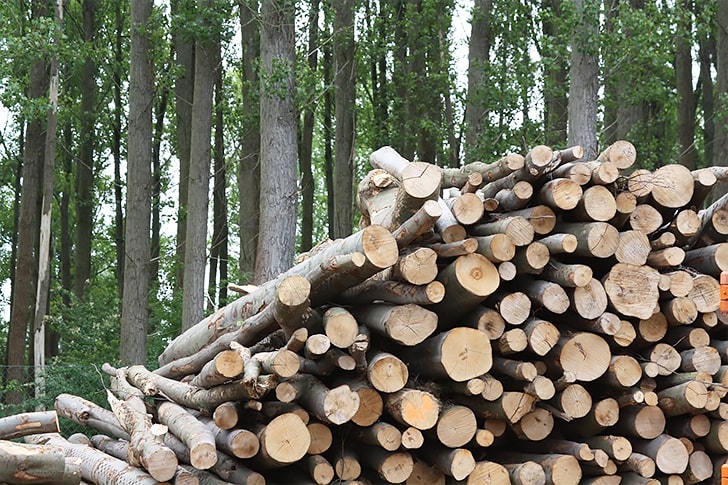
Despite knowing they’d lose income, the crew made a quiet agreement: they wouldn’t cut the tree further. The risk of destroying something historically important far outweighed the profits from one load of timber. Pete wrapped the base in flagging tape, marking it as off-limits. It was the least they could do.
They finished the day’s remaining tasks with an unusual sense of reverence. No more loud joking or music from the truck radio. Once done, they loaded the strange tree trunk carefully into the back of the flatbed. The plan was simple: take it somewhere more intelligent people could figure out what exactly they’d found inside.
The Right Choice
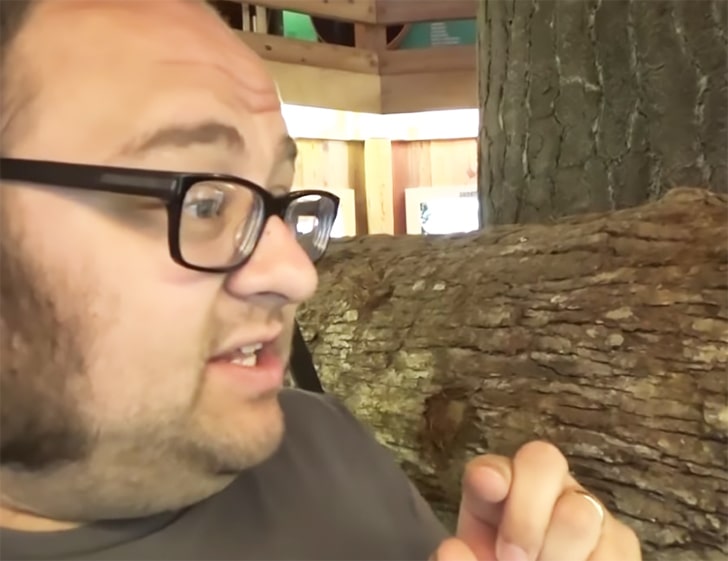
The loggers knew they weren’t biologists or historians. But they were smart enough to know when they were out of their depth. So, instead of cutting or reporting the find as waste, they contacted a local forestry liaison who promised to notify state scientists. That decision, they would later realize, was critical.
Weeks passed, then months. It took over a year before scientists returned with concrete answers. By then, most of the crew had moved on to other jobs or worksites. But those who’d been there that day remembered every detail. And when the results came in, the mystery wasn’t any less heartbreaking for being solved.
Museum Worthy
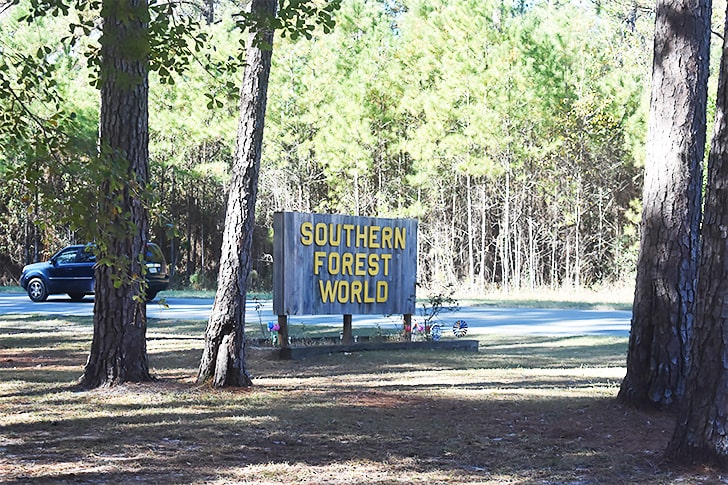
The tree and its occupant were eventually entrusted to a small museum called Southern Forest World in Waycross, Georgia. It was a fitting home, as the museum focused on forestry history and the impact of trees on human life. They accepted the piece even before the museum officially opened to the public.
The trunk was displayed intact, with the dog still nestled inside. There were no velvet ropes or flashy lighting, just a humble exhibit with a story that needed no embellishment. Visitors were drawn in, not just by the preservation, but by the sheer mystery of how nature had created something so oddly sacred inside a tree.
Spotlight in the Woods
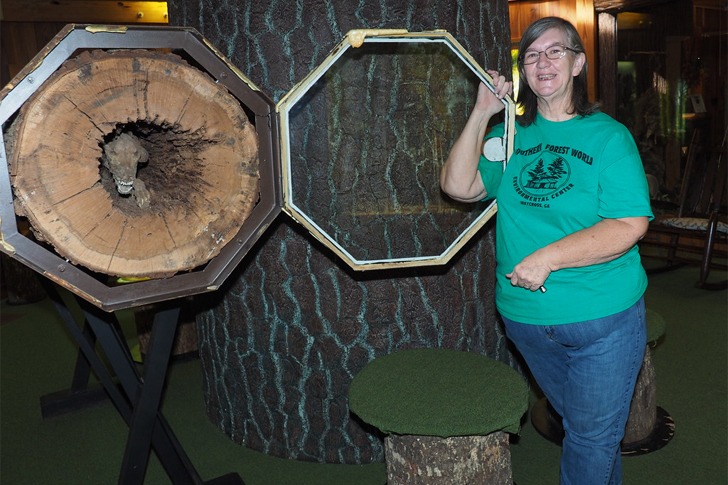
Word spread quickly. Once the museum opened, curious visitors began arriving, many just to see the “mummified dog in the tree.” Newspapers picked up the story, and before long, Stuckie (as he’d later be named) became the centerpiece of Southern Forest World’s collection. For something so tragic, it sparked a surprisingly big response.
But the museum wanted to understand it more than just show it. Where did this dog come from? How did it end up stuck 28 feet inside a tree? Theories abounded, but they needed science, not stories. That’s when experts from the anthropology field stepped in to help.
Science Steps In
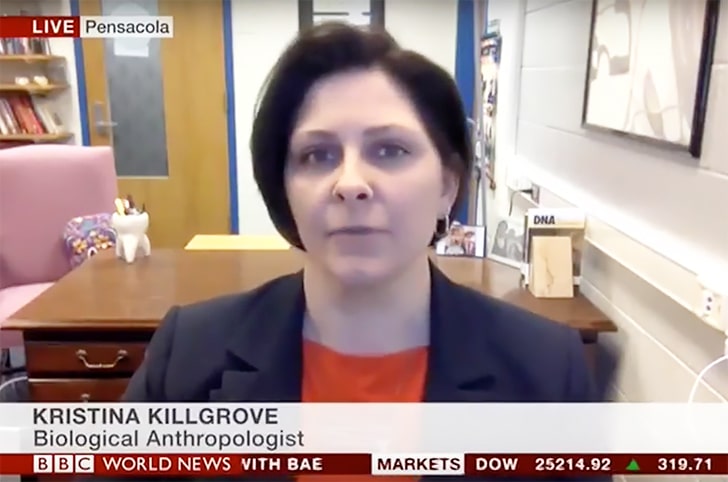
When the story began to attract attention, biological anthropologist Kristina Killgrove joined the effort to analyze the find. She examined the remains and explained that while the dog wasn’t intentionally mummified, the natural conditions inside the tree had mimicked preservation techniques. That began with putrefaction—or, in this case, the lack of it.
“Normally, microbes break down the body after death,” Kristina said. “They multiply and spread quickly.” But here, that didn’t happen. The dog hadn’t decayed the way most animals do. It hadn’t been embalmed, but the tree had acted like a tomb. Nature, by complete accident, had taken on the role of embalmer.
Chestnut’s Special Role
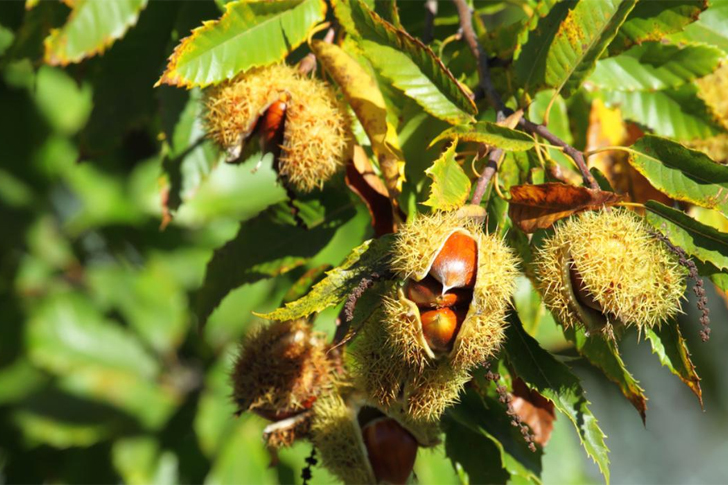
Kristina’s research was backed by the museum’s director, Bertha Sue Dixon, who explained the importance of the American chestnut tree. These trees contain tannins, organic compounds that absorb moisture and limit microbial growth. No moisture, no decomposition. Nature had created a perfectly dry chamber to protect the body.
Bertha also noted that no scavengers had ever found the carcass. “Anything that eats dead meat would never have known it was in there,” she said. Even if it had produced a scent, the chemical conditions and sealed trunk masked it. What should’ve rotted years ago remained untouched, frozen in time, high above the forest floor.
The Hunter Revealed
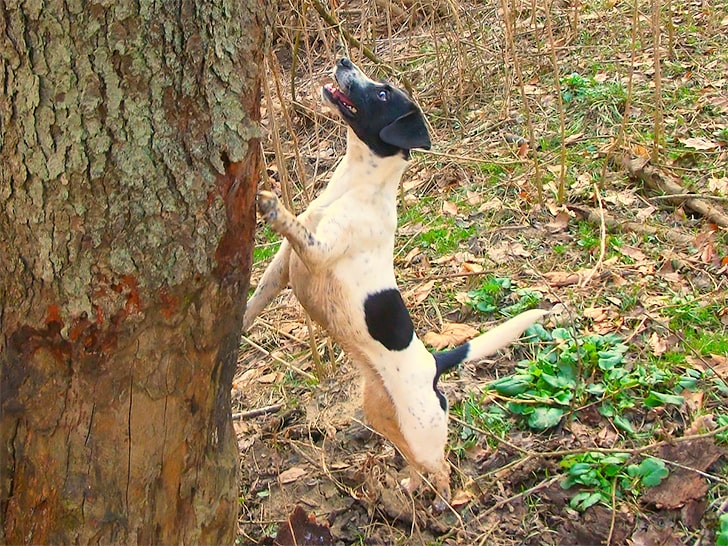
Eventually, the whole truth came to light. The dog had likely been a hunting companion, young, strong, and full of instinct. At four years old, he may have chased a raccoon or squirrel into the hollow and pursued it upward, not realizing the tree narrowed near the top. He simply got stuck.
Unable to turn around or escape, he likely panicked, tried to dig his way out, and eventually died of dehydration or exhaustion. There were no signs of external trauma. Only his position, 28 feet above the ground, told the tragic tale. He hadn’t been abandoned. He had followed his instincts. And they led him nowhere.
A Natural Tomb
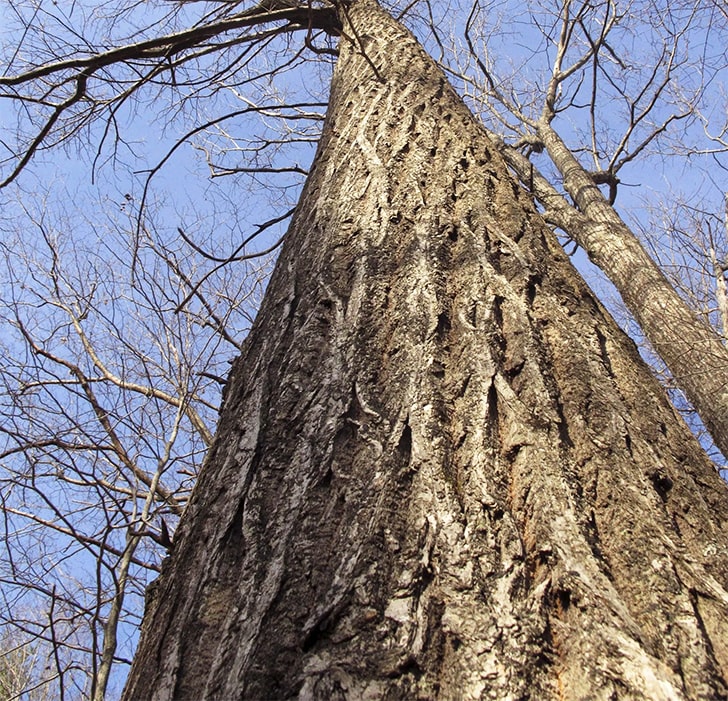
The museum explained another phenomenon: the “chimney effect.” Because the tree was hollow and open at the top, air flowed upward. This allowed odor to escape rather than linger, which would’ve attracted scavengers or insects. It also created a dry environment inside, further preserving the remains.
Combined with the tannic acid in the chestnut, the airflow helped dry and harden the dog’s tissue. His skin and fur remained intact, eerily lifelike. Although tragic, it created something scientifically rare. Over time, the dog became a centerpiece of the museum. His image appeared on postcards and brochures. Visitors didn’t just learn about trees—they met Stuckie.
A Name to Remember

For years, the dog was simply known as the “mummified dog in the tree.” But in 2002, the museum hosted a public naming contest. Finalists included “Dogwood,” “Chipper,” and “Stuckie.” The last name, a play on how he’d gotten trapped, won by a landslide. It was oddly perfect: sad, but not disrespectful.
Children from across the country submitted names and drawings, touched by his story. “Stuckie” went viral long before that was a buzzword. It gave the dog an identity, one that transformed him from an anonymous relic into a symbol of both loyalty and loss. His name added something powerful to the exhibit: heart.
Stuckie, Not Stuckey

Once the public chose the name “Stuckey,” the museum ran into an unexpected problem. That name was already tied to a nationwide chain of roadside convenience stores. The museum wanted to honor the dog, not start a trademark dispute, so it changed the spelling to “Stuckie” to avoid legal concerns.
It was a small change, but a necessary one. No one wanted a heartfelt tribute to end in court. This decision ensured the name stayed connected to the story and the museum’s purpose. The spelling might have changed, but the spirit of the dog who climbed too far never would. Stuckie had found his name and his place.
The Debate Over Display

Some people questioned the decision to keep Stuckie on display. While many saw him as a historical artifact, others felt he deserved a burial. Museum staff received letters suggesting he should be laid to rest out of respect. The debate reflected a broader truth: dogs aren’t just animals. They’re companions, even long after death.
Brandy Stevenson, the museum manager, shared that guests often react emotionally. “They ask how he got there. Then they say, ‘Poor little guy.’” Stuckie’s pose, mid-climb, mid-chase, captured something heartbreakingly relatable. His fate may have been accidental, but the emotional response he inspires is intentional. People don’t just view Stuckie. They feel him.
A Beloved Oddity
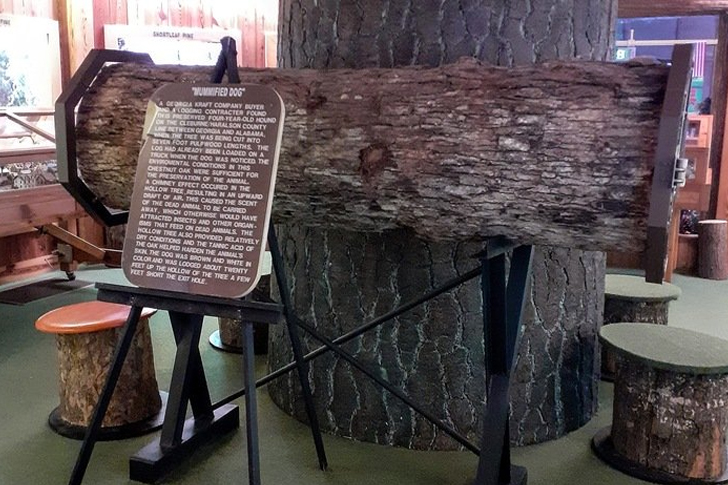
Since the exhibit’s unveiling, Stuckie has drawn thousands of curious visitors. Some come for the oddity. Others come for the story. Year after year, tourists of all ages stop by Southern Forest World just to catch a glimpse of the dog who became part of a tree. His natural preservation turned tragedy into education.
His body has remained perfectly intact inside that trunk for decades. Over time, he became a quiet icon of the museum, featured on merchandise, postcards, and even classroom materials. People may debate his fate, but one thing is clear; Stuckie has made more of an impact in death than most animals ever do in life.
Forever in the Forest
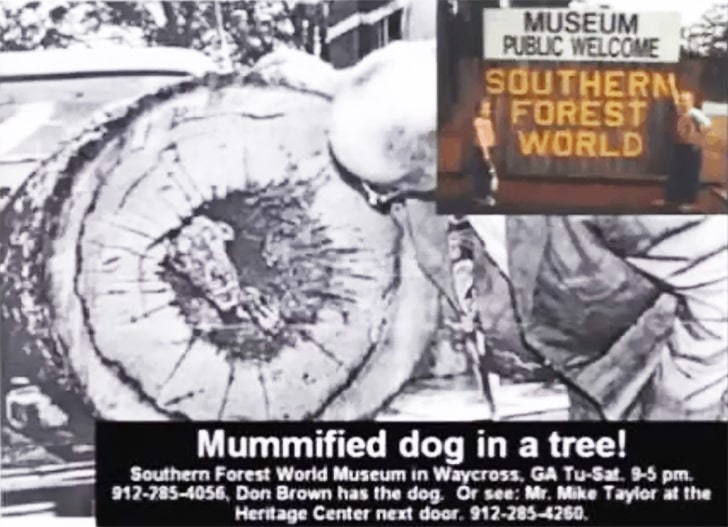
Stuckie’s story blends nature, science, and emotion in a way that few exhibits ever manage. From the moment he was discovered, his presence changed lives. The loggers who found him never forgot that day. The scientists who studied him marveled at what nature could do. Visitors continue to walk away in wonder.
The museum has no plans to remove him. Stuckie remains where he has been for more than two decades, curled inside his tree, frozen in time. He’s more than a display. He’s a reminder of instinct, loyalty, and the strange ways the world works. If you ever find yourself in Waycross, stop by and meet him.
